Perakam pita
Rencana ini ialah terjemahan daripada bahasa Inggeris. Terjemahan ini mungkin telah dihasilkan oleh komputer atau penterjemah tanpa kemahiran dalam bahasa lain. |
Bagi sistem pita yang digunakan untuk data komputer, lihat pemacu pita.

Satu perakam pita, dek pita atau mesin pita audio adalah peranti penyimpanan audio yang merekodkan dan memainkan semula bunyi, termasuk suara percakapan, yang biasanya menggunakan pita magnet, sama ada digulung pada gelendong atau dalam bentuk kaset, sebagai simpanan. Dalam bentuk hari ini, ia merakamkan isyarat turun naik dengan menggerakkan pita melalui kepala pita yang mengutubkan medan magnet dalam pita berkadaran dengan isyarat audio. Alat perakam pita termasuk dek pita gelendong ke gelendong dan dek kaset.
Penggunaan pita magnet untuk rakaman bunyi bermula sekitar 1930. Pita bermagnet mengubah kedua-dua industri penyiaran radio dan rakaman muzik. Ia memberikan artis dan pengeluar kuasa untuk merakam dan merakam semula rekod audio dengan kehilangan kualiti yang rendah serta mengedit dan menyusun semula rakaman dengan mudah. Teknologi rakaman alternatif pada era tersebut, cakera transkripsi dan perakam wayar , tidak mampu menyaingi tahap kualiti dan fungsi pada tahap yang serupa. Disebabkan beberapa peningkatan awal meningkatkan fideliti bunyi yang dihasilkan semula, pita magnetik memberikan kualiti rakaman analog tertinggi yang ada. Walau bagaimanapun, pada dekad pertama abad ke-21, pita magnetik analog kebanyakannya telah digantikan dengan rakaman teknologi digital bagi tujuan kebanyakan rakaman bunyi.
Sebelum pembangunan pita magnet, perakam wayar magnetik telah berjaya mempamerkan konsep rakaman magnetik, tetapi ia tidak pernah menawarkan kualiti audio yang setanding dengan rakaman dan penyiaran piwaian lain pada masa itu. Sesetengah individu dan organisasi membangunkan kegunaan inovatif bagi perakam wayar bermagnet manakala yang lain menyelidik teknologi variasi. Satu perubahan penting adalah pemakaian bedak oksida pada jalur kertas yang panjang. Ciptaan Jerman ini merupakan permulaan rentetan inovasi yang panjang yang telah membawa hingga perakam pita magnet pada hari ini.
Sejarah[sunting | sunting sumber]

Varian terawal: perakam jalur lilin bukan bermagnet[sunting | sunting sumber]
Perakam pita audio yang paling awal diketahui versi bukan bermagnet, bukan elektrik yang dicipta oleh makmal Volta Alexander Graham Bell dan dipatenkan pada tahun 1886 (U.S. Patent 341,214).[1] Ia menggunakan satu jalur kertas lilin 16/3 inci lebar (4.8 mm) yang dilindungi dengan mencelup ia dalam larutan lilin lebah dan parafin dan kemudian mempunyai satu sisi yang dikikis licin, sementara sisi yang lain dibenarkan mengeras. Mesin ini dibina dengan menggunakan kayu dan logam yang kukuh, dan berkuasa tangan melalui tombol yang dilekatkan pada roda tenaga . Jalur lilin melalui satu gelendung satu per lapan inci mengelilingi pinggir takal (dengan panduan bebibir) yang dipasang pada takal-V pada aci menegak utama, di mana ia bertembung dengan sama ada stylus perakam atau pemain balik. Pita itu kemudiannya digulung pada gelendong lain. Stylus perakam yang tajam, digetarkan oleh diafragma mika bergetar, mengukir lilin dari jalur. Dalam mod main balik, stylus tumpul, dipasang longgar, dilekatkan pada diafragma getah, membawa bunyi yang dihasilkan semula melalui tiub telinga kepada pendengar itu.[1]
Kedua-dua kepala rakaman dan main semula, dipasang silang-seli pada dua tiang, yang boleh diselaraskan secara menegak agar beberapa rakaman boleh dipotong pada jalur 16/3 inci lebar (4.8 mm) yang sama. Walaupun mesin ini tidak pernah dibangunkan secara komersial, ia adalah satu moyang menarik bagi perakam pita magnetik moden yang menyerupai dari segi reka bentuknya. Pita dan mesin yang dibuat oleh syarikat-syarikat sekutu Bell, diperiksa di salah sebuah Institusi muzium Smithsonian, menjadi rapuh, dan kertas gulungan yang berat meleding. Kepala main balik mesin juga hilang. Jika tidak, dengan beberapa pemulihan, ia boleh dipulihkan kembali berfungsi.[1]
Tolong bantu menterjemahkan sebahagian rencana ini. Rencana ini memerlukan kemaskini dalam Bahasa Melayu piawai Dewan Bahasa dan Pustaka. Sila membantu, bahan-bahan boleh didapati di Perakam pita (Inggeris). Jika anda ingin menilai rencana ini, anda mungkin mahu menyemak di terjemahan Google. Walau bagaimanapun, jangan menambah terjemahan automatik kepada rencana, kerana ini biasanya mempunyai kualiti yang sangat teruk. Sumber-sumber bantuan: Pusat Rujukan Persuratan Melayu. |
Photoelectric variant[sunting | sunting sumber]
In 1932, after six years of developmental work, Merle Duston, a Detroit radio engineer, created a tape recorder that used a low-cost chemically treated paper tape, capable of recording both sounds and voice. During the recording process, the tape moved through a pair of electrodes which immediately imprinted the modulated sound signals as visible black stripes into the paper tape's surface. The sound track could be immediately replayed from the same recorder unit, which also contained photoelectric sensors, somewhat similar to the various motion picture sound-on-film technologies of the era.[2][3]
On 13 August 1931, Duston filed USPTO Patent Application #556,743 for "Method Of And Apparatus For Electrically Recording And Reproducing Sound And Other Vibrations", and which was renewed in 1934.[4][5]
Magnetic recording[sunting | sunting sumber]
Magnetic recording was conceived as early as 1877 by the American engineer Oberlin Smith and demonstrated in practice in 1898 by Danish engineer Valdemar Poulsen. Analog magnetic wire recording, and its successor, magnetic tape recording, involve the use of a magnetizable medium which moves with a constant speed past a recording head. An electrical signal, which is analogous to the sound that is to be recorded, is fed to the recording head, inducing a pattern of magnetization similar to the signal. A playback head can then pick up the changes in magnetic field from the tape and convert it into an electrical signal.
Steel wire magnetic recorder variant[sunting | sunting sumber]
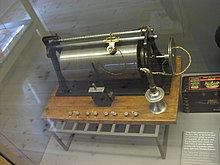
The first wire recorder was the Valdemar Poulsen Telegraphone of the late 1890s, and wire recorders for law/office dictation and telephone recording were made almost continuously by various companies (mainly the American Telegraphone Company) through the 1920s and 1930s. These devices were mostly sold as consumer technologies after World War II.
Widespread use of the wire recording device occurred within the decades spanning from 1940 until 1960, following the development of inexpensive designs licensed internationally by the Brush Development Company of Cleveland, Ohio and the Armour Research Foundation of the Armour Institute of Technology (later Illinois Institute of Technology).[perlu rujukan] These two organizations licensed dozens of manufacturers in the U.S., Japan, and Europe.[perlu rujukan] Wire was also used as a recording medium in black box voice recorders for aviation in the 1950s.
Consumer wire recorders were marketed for home entertainment or as an inexpensive substitute for commercial office dictation recorders, but the development of consumer magnetic tape recorders starting in 1946, with the BK 401 Soundmirror,using paper-based tape,[6] quickly drove wire recorders from the market.[perlu rujukan]
Early steel tape recorders[sunting | sunting sumber]
In 1924 a German engineer, Dr. Kurt Stille, developed the Poulsen wire recorder as a dictating machine. The following year a fellow German Louis Blattner, working in Britain, licensed Stille's device and started work on the developments which produced the Blattnerphone,[7] now using steel tape.

The BBC installed a Blattnerphone at Avenue House in September 1930 for tests, and used it to record King George V's speech at the opening of the India Round Table Conference on 12 November 1930. Though not considered suitable for music the machine continued in use and was moved to Broadcasting House in March 1932, a second machine also being installed.
The tape was 6mm wide and 0.08mm thick, travelling at 5 feet per second; the recording time was 20 minutes.
In September 1932 a new model was installed, using 3mm tape with a recording time of 32 minutes.
In 1933 the Marconi Company purchased the rights to the Blattnerphone, and newly developed Marconi-Stille recorders were installed in the BBC's Maida Vale Studios in March 1935.[8] The quality was slightly improved, though it still tended to be obvious that one was listening to a recording, as was the reliability. A reservoir system containing a loop of tape helped to stabilize the speed (there was also a smaller one just before the heads). The tape was 3mm wide and travelled at 1.5 metres/second. By September there were three recording rooms, each with two machines.
They were hardly easy to handle. The spools were heavy (and expensive) and the tape has been described as being like a travelling razor blade. The tape was liable to snap, particularly at joints, which at that speed could rapidly cover the floor with loops of the sharp-edged tape. Rewinding was done at twice the speed of the recording.
However despite all this, the ability to make replayable recordings was extremely useful, and even with subsequent methods coming into use (direct-cut discs[9] and Philips-Miller optical film[10]) the Marconi-Stilles remained in use until the late 1940s.[11]
German developments[sunting | sunting sumber]
Magnetic tape recording as we know it today was developed in Germany during the 1930s at BASF (then part of the chemical giant IG Farben) and AEG in cooperation with the RRG. This was based on Fritz Pfleumer's 1928 invention of paper tape with oxide powder lacquered to it. The first practical tape recorder from AEG was the Magnetophon K1, demonstrated in Germany in 1935. Eduard Schüller of AEG built the recorders and developed a ring shaped recording and playback head. It replaced the needle shaped head which tended to shred the tape. Friedrich Matthias of IG Farben/BASF developed the recording tape, including the oxide, the binder, and the backing material. Walter Weber, working for Hans Joachim von Braunmühl at the RRG, discovered the AC biasing technique, which radically improved sound quality.[12]
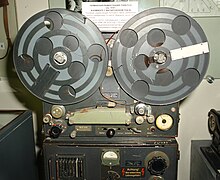
During World War II, the Allies noticed that certain German officials were making radio broadcasts from multiple time zones almost simultaneously.[12] Analysts such as Richard H. Ranger believed that the broadcasts had to be transcriptions, but their audio quality was indistinguishable from that of a live broadcast[12] and their duration was far longer than was possible with 78 rpm discs. (The Allies were aware of the existence of the pre-war Magnetophon recorders, but not of the introduction of high-frequency bias and PVC-backed tape.)[13] In the final stages of the war in Europe, the Allied capture of a number of German Magnetophon recorders from Radio Luxembourg aroused great interest. These recorders incorporated all of the key technological features of modern analog magnetic recording and were the basis for future developments in the field.
Commercialization[sunting | sunting sumber]
American developments[sunting | sunting sumber]
Development of magnetic tape recorders in the late 1940s and early 1950s is associated with the Brush Development Company and its licensee, Ampex. The equally important development of the magnetic tape media itself was led by Minnesota Mining and Manufacturing (3M) corporation.
In 1938, S.J. Begun left Germany and joined the Brush Development Company in the United States, where work continued but attracted little attention until the late 1940s when the company released the very first consumer tape recorder in 1946: the Soundmirror BK 401.[6] Several other models were quickly released in the following years. Tapes were initially made of paper coated with magnetite powder. Minnesota Mining & Manufacturing Company (3M) replaced them by plastic tapes in 1948.[meragukan ][perlu rujukan]
American audio engineer John T. Mullin and entertainer Bing Crosby were key players in the commercial development of magnetic tape. Mullin served in the U.S. Army Signal Corps and was posted to Paris in the final months of WWII. His unit was assigned to find out everything they could about German radio and electronics, including the investigation of claims that the Germans had been experimenting with high-energy directed radio beams as a means of disabling the electrical systems of aircraft. Mullin's unit soon amassed a collection of hundreds of low-quality magnetic dictating machines, but it was a chance visit to a studio at Bad Nauheim near Frankfurt while investigating radio beam rumours, that yielded the real prize.
Mullin was given two suitcase-sized AEG 'Magnetophon' high-fidelity recorders and fifty reels of recording tape. He had them shipped home[12] and over the next two years he worked on the machines constantly, modifying them and improving their performance. His major aim was to interest Hollywood studios in using magnetic tape for movie soundtrack recording.
Mullin gave two public demonstrations of his machines, and they caused a sensation among American audio professionals; many listeners literally could not believe that what they were hearing was not a live performance. By luck, Mullin's second demonstration was held at MGM studios in Hollywood and in the audience that day was Bing Crosby's technical director, Murdo Mackenzie. He arranged for Mullin to meet Crosby and in June 1947 he gave Crosby a private demonstration of his magnetic tape recorders.[12]
Bing Crosby's influence[sunting | sunting sumber]
Bing Crosby, a top movie and singing star, was stunned by the amazing sound quality and instantly saw the huge commercial potential of the new machines. Live music was the standard for American radio at the time and the major radio networks didn't permit the use of disc recording in many programs because of their comparatively poor sound quality. Crosby disliked the regimentation of live broadcasts 39 weeks a year,[12] preferring the recording studio's relaxed atmosphere and ability to retain the best parts of a performance. He had asked NBC to let him pre-record his 1944-45 series on transcription discs, but the network refused, so Crosby had withdrawn from live radio for a year. ABC agreed to let him use transcription discs for the 1946-47 season, but listeners complained about the sound quality.[12]
Mullin's tape recorder came along at precisely the right moment. Crosby realised that the new technology would enable him to pre-record his radio show with a sound quality that equalled live broadcasts, and that these tapes could be replayed many times with no appreciable loss of quality. Mullin was asked to tape one show as a test and was immediately hired as Crosby's chief engineer to pre-record the rest of the series.
Crosby's season premier on 1 October 1947 was the first magnetic tape broadcast in America.[12] He became the first major American music star to use tape to pre-record radio broadcasts, and the first to master commercial recordings on tape. The taped Crosby radio shows were painstakingly edited through tape-splicing to give them a pace and flow that was wholly unprecedented in radio. Mullin even claims to have been the first to use "canned laughter"; at the insistence of Crosby's head writer, Bill Morrow, he inserted a segment of raucous laughter from an earlier show into a joke in a later show that hadn't worked well. Soon other radio performers were demanding the ability to prerecord their broadcasts with the high quality of tape, and the recording ban was lifted.[12]
Keen to make use of the new recorders as soon as possible, Crosby invested $50,000 of his own money into the Californian electronics company Ampex, and the tiny six-man concern (headed by Alexander M. Poniatoff, whose initials became part of the company name) soon became the world leader in the development of tape recording, revolutionising radio and recording with its famous Model 200 tape deck, issued in 1948 and developed directly from Mullin's modified Magnetophons.
Tape recording at the BBC[sunting | sunting sumber]
The BBC acquired some Magnetophone machines in 1946 on an experimental basis, and these were used in the early stages of the new Third Programme to record and play back performances of operas from Germany (live relays being problematic because of the unreliability of the landlines in the immediate post-war period).

These machines were used until 1952, though most of the work continued to be done using the established media; but from 1948 a new British model became available from EMI: the BTR1. Though in many ways clumsy, its quality was good, and as it wasn't possible to obtain any more Magnetophones it was an obvious choice.
In 1963 The Beatles were allowed to enhance their recordings at the BBC by overdubbing. The BBC didn't have any multi track tapes. They would copy them onto another tape.
In the early 1950s the EMI BTR 2 became available (right); a much improved machine and generally liked. It became the standard in recording channels (rooms) for many years, and was in use until the end of the 1960s.
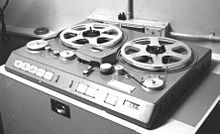
The machines were responsive, could run up to speed quite quickly, had light-touch operating buttons, forward-facing heads (The BTR 1s had rear-facing heads which made editing difficult), and were quick and easy to do the finest editing on.
The tape speed was eventually standardized at 15 ips for almost all work at Broadcasting House, and at 15 ips for music and 7½ ips for speech at Bush House. Broadcasting House also used the EMI TR90 and a Philips machine which was lightweight but very easy and quick to use: Bush House used several Leevers-Rich models.
The Studer range of machines had become pretty well the studio recording industry standard by the 1970s, and gradually these replaced the ageing BTR2s in recording rooms and studios. By the mid-2000s tape was pretty well out of use and had been replaced by digital playout[14] systems.[15]
Standardized products[sunting | sunting sumber]
Working with Mullin in The USA, Ampex rapidly developed two-track stereo and then three-track recorders.
The typical professional audio tape recorder of the early 1950s used ¼" wide tape on 10½" reels, with a capacity of 2400 feet (730 metres). Typical speeds were initially 15 in/s (38.1 cm/s) yielding 30 minutes' recording time on a 2400 ft (730 m) reel. 30 in/s (76.2 cm/s) was used for the highest quality work. Domestic and portable recorders used seven, five or even three inch reels (or spools). Early professional machines used single sided spools but double sided spools soon became popular (particularly for domestic use). Tape spools were usually made from transparent plastic but metal spools were also used.
Standard tape speeds varied by factors of two — 15 and 30 in/s were used for professional audio recording; 7½ in/s (19 cm/s) for home audiophile prerecorded tapes; 7½ and 3¾ in/s (19 and 9.5 cm/s) for audiophile and consumer recordings (typically on 7 in or 18 cm reels). 1⅞ in/s (4.76 cm/s) and occasionally even 15/16 in/s (2.38 cm/s) were used for voice, dictation, and applications where very long recording times were needed, such as logging police and fire department calls.
The 8-Track tape standard, promoted by Bill Lear in the early 1960s, popularized consumer audio playback in automobiles. Eventually, this standard was replaced by the smaller and more reliable Compact Cassette.
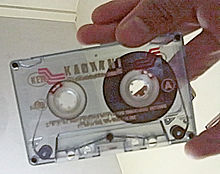
Philips' development of the Compact Cassette in 1963 and Sony's development of the Walkman in 1979 [16] led to widespread consumer use of magnetic audio tape. In 1990, the Compact Cassette was the dominant format in mass-market recorded music.[17] The development of Dolby noise reduction technology in the 1960s brought audiophile quality recording to the Compact Cassette also contributing to its popularity.
Later developments[sunting | sunting sumber]
Since their first introduction, analog tape recorders have experienced a long series of progressive developments resulting in increased sound quality, convenience, and versatility.
- Two-track and, later, multi-track heads permitted discrete recording and playback of individual sound sources, such as two stereophonic channels, or different microphones during live recording. The more versatile machines could be switched to record on some tracks while playing back others, permitting additional tracks to be "laid down" in synchronisation with previously recorded material such as a rhythm track.
- Use of separate heads for recording vs. playback (three heads total, counting the erase head) enabled monitoring of the recorded signal a fraction of a second after recording. Mixing the playback signal back into the record input also created a primitive echo generator.
- Dynamic range compression during recording and expansion during playback expanded the available dynamic range and improved the signal-to-noise ratio. dbx and Dolby Laboratories introduced add-on products in this area, originally for studio use, and later in versions for the consumer market. In particular, "Dolby B" noise reduction became very common in all but the least expensive cassette tape recorders.
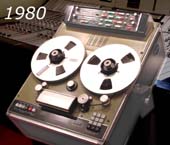
- Computer-controlled analog tape recorders were introduced by Oscar Bonello in Argentina.[18] The mechanical transport used three DC motors and introduced two new advances: automated microprocessor transport control and automatic adjustment of bias and frequency response. In 30 seconds the recorder adjusted its bias for minimum THD and best frequency response to match the brand and batch of magnetic tape used. The microprocessor control of transport allowed fast location of any point on the tape.
Operation[sunting | sunting sumber]
Electrical[sunting | sunting sumber]
Electric current flowing in the coils of the tape head creates a fluctuating magnetic field. This causes the magnetic material on the tape, which is moving past and in contact with the head, to align in a manner proportional to the original signal. The signal can be reproduced by running the tape back across the tape head, where the reverse process occurs – the magnetic imprint on the tape induces a small current in the read head which approximates the original signal and is then amplified for playback. Many tape recorders are capable of recording and playing back at once by means of separate record and playback heads in line or combined in one unit.
Mechanical[sunting | sunting sumber]
Modern professional recorders usually use a three-motor scheme. One motor with a constant rotational speed drives the capstan. This, usually combined with a rubber pinch roller, ensures that the tape speed does not fluctuate. The other two motors, which are called Torque Motors, apply equal and opposite torques to the supply and take up reels during recording and play back functions and maintain the tape's tension. During fast winding operations the pinch roller is disengaged and the take up reel motor is supplied with a higher voltage than the supply motor. The cheapest models use a single motor for all required functions; the motor drives the capstan directly and the supply and take-up reels are loosely coupled to the capstan motor with slipping belts or clutches. There are also variants with two motors, in which one motor is used for rewinding only.

Limitations[sunting | sunting sumber]
The storage of an analogue signal on tape works well, but is not perfect. In particular, the granular nature of the magnetic material adds high-frequency noise to the signal, generally referred to as tape hiss. Also, the magnetic characteristics of tape are not linear. They exhibit a characteristic hysteresis curve, which causes unwanted distortion of the signal. Some of this distortion is overcome by using an inaudible high-frequency AC bias signal when recording, though the amount of bias needs careful adjustment for best results. Different tape material requires differing amounts of bias, which is why most recorders have a switch to select this (or, in a cassette recorder, switch automatically based on cutouts in the cassette shell). Additionally, systems such as Dolby noise reduction systems (Dolby B, Dolby C, Dolby S and Dolby HX-Pro) have been devised to ameliorate some of the noise and distortion problems. Variations in tape speed cause flutter, which can be reduced by using dual capstans. Higher speeds used in professional recorders are prone to cause "head bumps," which are fluctuations in low-frequency response.
Tape recorder variety[sunting | sunting sumber]

There are a wide variety of tape recorders in existence, from small hand-held devices to large multitrack machines. A machine with built-in speakers and audio power amplification to drive them is usually called a "tape recorder" or – if it has no record functionality – a "tape player," while one that requires external amplification for playback is usually called a "tape deck" (regardless of whether it can record).
Multitrack technology enabled the development of modern art music and one such artist, Brian Eno, described the tape recorder as "an automatic musical collage device".
Uses[sunting | sunting sumber]


Magnetic tape brought about sweeping changes in both radio and the recording industry. Sound could be recorded, erased and re-recorded on the same tape many times, sounds could be duplicated from tape to tape with only minor loss of quality, and recordings could now be very precisely edited by physically cutting the tape and rejoining it. In August, 1948, Los Angeles-based Capitol Records became the first recording company to use the new process.[19]
Within a few years of the introduction of the first commercial tape recorder, the Ampex 200 model, launched in 1948, American musician-inventor Les Paul had invented the first multitrack tape recorder, bringing about another technical revolution in the recording industry. Tape made possible the first sound recordings totally created by electronic means, opening the way for the bold sonic experiments of the Musique Concrète school and avant garde composers like Karlheinz Stockhausen, which in turn led to the innovative pop music studio recordings of artists such as Frank Zappa, The Beatles and The Beach Boys.
Tape enabled the radio industry for the first time to pre-record many sections of program content such as advertising, which formerly had to be presented live, and it also enabled the creation and duplication of complex, high-fidelity, long-duration recordings of entire programs. It also, for the first time, allowed broadcasters, regulators and other interested parties to undertake comprehensive logging of radio broadcasts for legislative and commercial purposes, leading to the growth of the modern media monitoring industry.
Innovations, like multitrack recording and tape echo, enabled radio programs and advertisements to be pre-produced to a level of complexity and sophistication that was previously unattainable and tape also led to significant changes to the pacing of program content, thanks to the introduction of the endless-loop tape cartridge.
An important use of tape recorders is the recording of video. Video cassette recorders differ substantially from audio recorders due to the use of a rotating magnetic head that uses a helical scan over the tape medium. Helical scans increase the relative speed of the tape surface over the head.
While they are primarily used for sound recording, tape machines were also important for data storage before the advent of floppy disks and CDs, and are still used today, although primarily to provide an offline backup to hard disk drives.
Tapedeck speeds[sunting | sunting sumber]
Professional decks will use higher tape speeds, with 15 and 30 inches per second being most common, while lower tape speeds are usually used for smaller recorders and cassette players, in order to save space where fidelity is not as critical as in professional recorders. By providing a range of tape speeds, users can trade-off recording time against signal quality with higher tape speeds providing greater frequency response.
There are many different tape speeds which are in use in all sorts of tape recorders. Speed may be expressed in centimeters per second (cm/s) or in inches per second (in/s).
| cm/s | in/s |
|---|---|
| 1.2 | 15/32[20] |
| 2.4 | 15/16 |
| 4.75 | 17⁄8 |
| 9.5 | 33⁄4 |
| 19 | 71⁄2 |
| 38 | 15 |
| 76 | 30 |
Lihat juga[sunting | sunting sumber]
- Audio editing
- Audio tape length and thickness - Details of different audio tape formats.
- Digital audio – History of digital audio use in commercial recording
- Digital voice recorder
- Electromagnetism
- Electronic music
- History of sound recording – Magnetic recording - Magnetic tape in the context of the history of sound recording.
- Multitrack recording - Advanced usage of sophisticated tape recorders.
- Preservation of magnetic audiotape
- Reel-to-reel audio tape recording - Details of using old style recorders.
- Sound follower - For film
- Sound recording and reproduction
- Volta Laboratory-Sound recording
- Wire recording
Format pita[sunting | sunting sumber]
| Type | Image |
|---|---|
| 8-track tape | |
| Cassette deck | 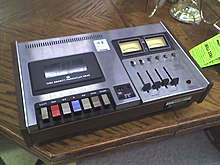 |
| Compact audio cassette |  |
| Microcassette |  |
| Digital Audio Tape (DAT) |  |
| Elcaset |  |
| Helical scan |  |
| Reel-to-reel audio tape recording | 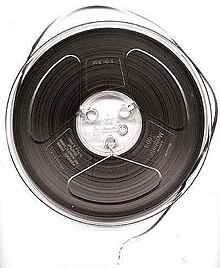 |
| Wire recording | 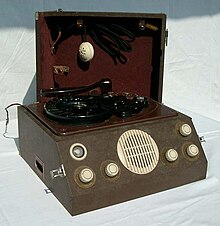 |
| RCA tape cartridge | 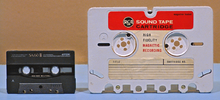 |
Nota[sunting | sunting sumber]
- ^ a b c Newville, Leslie J. Development of the Phonograph at Alexander Graham Bell's Volta Laboratory, United States National Museum Bulletin, United States National Museum and the Museum of History and Technology, Washington, D.C., 1959, No. 218, Paper 5, pp.69-79. Retrieved from ProjectGutenberg.org.
- ^ Popular Science. Record Of Voice Now Made On Moving Paper Tape, Popular Science, Bonnier Corporation, February 1934, pp.40, Vol. 124, No. 2, ISSN 0161-7370.
- ^ Onosko, Tim. Wasn't The Future Wonderful?: A View Of Trends And Technology From The 1930s: (article) Book Reads Itself Aloud: After 500 Years, Books Are Given Voice, Dutton, 1979, pp.73, ISBN 0-525-47551-6, ISBN 978-0-525-47551-4. Article attributed to: Popular Mechanics, date of publication unstated, likely c. February 1934.
- ^ USPTO. Official Gazette Of The United States Patent Office, United States Patent Office, 1936, Volume 463, pp.537.
- ^ USPTO. United States Patent Office, Patent US2030973 A, "Method of and apparatus for electrically recording and reproducing sound or other vibrations"
- ^ a b "BRUSH DEVELOPMENT CORP". The Encyclopedia of Cleveland History. 29 Mei 2002.
- ^ Blattnerphone, dicapai pada 11 Disember 2013
- ^ Marconi-Stille recorders, dicapai pada 11 Disember 2013
- ^ Directly-cut discs, dicapai pada 11 Disember 2013
- ^ Optical film, dicapai pada 11 Disember 2013
- ^ Information in this section from 'BBC Engineering 1922-1972' by Edward Pawley, pp178-182; plus some from colleagues who worked in BH in the 1930s.
- ^ a b c d e f g h i Fenster, J.M. "How Bing Crosby Brought You Audiotape Diarkibkan 2011-04-04 di Wayback Machine". Invention & Technology, Fall 1994.
- ^ Information from 'BBC Engineering 1922-1972' by Edward Pawley, page 387.
- ^ Web page about digital playout
- ^ Information in this section from 'BBC Engineering 1922-1972' by Edward Pawley, p387ff and 488ff plus personal experience.
- ^ First Sony Walkman introduced
- ^ Recording Enters a New Era, And You Can't Find It on LP
- ^ "A new tape transport system with digital control", Oscar Bonello, Journal of Audio Engineering Society, Vol 31 # 12, December 1983
- ^ "The Capitol Story--A Decade of Growth and Success." Billboard, 2 August 1952
- ^ "Martel Electronics. Terms commonly used for Tape Recorder. Tape Recorder Speed.". Diarkibkan daripada yang asal pada 1 Mac 2012. Dicapai pada 29 Mei 2015.
Rujukan[sunting | sunting sumber]
- This article incorporates text from the United States National Museum Bulletin, a government publication in the public domain.
Pautan luar[sunting | sunting sumber]
| Wikimedia Commons mempunyai media berkaitan Perakam pita |
- Tape Recorder - Interactive Java Tutorial National High Magnetic Field Laboratory
- WikiRecording's Guide to Analog Tape
- A timeline of developments in magnetic recording.
- A History of Magnetic Recording BBC/H2G2
- A Selected History of Magnetic Recording
- Walter Weber's Technical Innovation at the Reichs-Rundfunk-Gesellschaft
- Timeline from U of San Diego's Archive
- History of Recording Technology (WayBack Machine)
- History of Magnetic Tape (WayBack Machine)
- Description of the recording process with diagrams. pg. 2, pg. 3, pg. 4, pg. 5.
- Recording at the BBC - a brief history of various sound recording methods used by the BBC.
- Rencana Wikipedia yang memerlukan pembersihan selepas diterjemahkan
- Rencana Wikipedia yang memerlukan pembersihan selepas diterjemahkan daripada en
- Semua rencana dengan kenyataan tidak bersumber dari July 2009
- Rencana dengan pernyataan yang dipertikaikan dari May 2010
- Semua rencana dengan kenyataan tidak bersumber dari May 2010
- Guna tarikh dmy dari February 2011
- Audio storage
- Sound production technology
- Sound recording
- Sound recording technology
- Articles containing video clips
